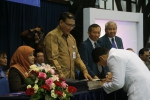ITB School of Pharmacy Lecturer Formulates Superior Antibiotic with Tokyo Institute of Technology
BANDUNG, itb.ac.id—The collaboration for dozens of years has made Institut Teknologi Bandung and Tokyo Institute of Technology (TIT) succeed in publishing excellent journal publications and patent proposals. This collaboration came from the lecturer of ITB School of Pharmacy Pharmacochemistry Research Group, Dr. apt. Ilma Nugrahani, S.Farm., M.Si. She succeeded in formulating superior antibiotics with Hidehiro Uekusa, Ph.D. as the owner of Uekusa Laboratory TIT in Tokyo, Japan.
Since a long time ago, the world has always been at a never-ending war with various diseases. Infectors have the ability to mutate one after another, while humans inevitably have to adapt in order to defend themselves. Drugs then become one of the weapons of self-defense after food.
The development of antibiotics as an effective antidote to infectors, also does not stop there. Various types of antibiotics have been developed and adapted to the development of the disease based on their structure. One of them is the fluoroquinolone group which is currently widely prescribed such as ciprofloxacin and levofloxacin.
The effectiveness of antibiotics can be seen from their chemical and physical structure. Unfortunately, most antibiotics have poor solubility in water, which reduces their performance to be absorbed by the body. Various ways have been done to find a breakthrough on this issue. One of them is to make multicomponent materials combined with drugs to create ionic and neutral bonds that are more easily digested by the body. Dr. Ilma then developed antibiotics by increasing their effectiveness from this background point of view.
“Multicomponent systems can be drug combination or drug-excipient. For the last few years, we have intensively developed and analyzed the drug solids to produce new multicomponent antibiotic systems with superior performance.” Said Dr. Ilma in her writings on ITB Engineering Rubric in Media Indonesia, 27th June 2021. Check out other interesting articles on the https://pengabdian.lppm.itb.ac.id/ page.
The research was started from the search for coformers through literature studies to find those that fit the criteria for pharmacological safety, stability, and have groups that can bind to drugs. Salt formation usually occurs when the difference in the acidity of the salt (pKa) is more than three, whereas if it less than that the components will result in a neutral multicomponent system called cocrystal.
The multicomponent system is then determined by molar ratios to create a phase diagram that will display a W-shape phase with two eutectic points (lower melting temperature of each component). This eutectic point is used as an indicator of the interaction of the multicomponent system. After going through the isolation process of multicomponent single crystals by mixing, dissolving, and evaporation of solvents, the results were then characterized by various instrumentation of solids in sequence, namely thermal analysis, spectroscopy, infrared, x-ray diffraction, powders, and single crystal x-ray diffraction.
“We develop multicomponent crystals from the materials of ciprofloxacin and levofloxacin using solid engineering techniques,” explained Dr. Ilma. Ciprofloxacin has a pKa of 6.09, whereas that of levofloxacin is 5.45. Their solubility is low in water. Considering that fluoroquinolone antibiotics are acid soluble, coformers with lower acidity were chosen, namely citric acid (pKa = 3.13) and salicylic acid (pKa = 2.79). Both acids are soluble in water, have good stability, and are easy to obtain. On the other hand, both also have their own antibacterial and antioxidant activity.
Finally, it was observed that the resulting multicomponent system could increase the solubility of fluoroquinolone antibiotics by more than 10 times. From the observation of microbiological potential, there was an increase in activity up to 1.5 times, which means it could reduce the dose of antibiotics.
Dr. Ilma said the development of the multicomponent system was basically simple. It's just that various instrumentations are needed which may not be found in industry or in laboratories in the country. These devices include visual observations, thermal analysis, vibration spectrophotometers, and x-ray diffraction. According to her, it is appropriate for students and researchers to master the latest solid analysis and engineering methods so that they are not left behind from other countries.
Reporter: Lukman Ali (Teknik Mesin, 2020)
Translator: Aghisna Syifa R (Biologi, 2020)

scan for download








